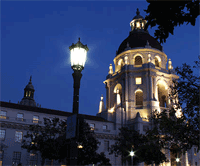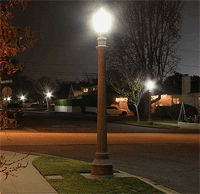Ever since it erected its first lamp posts in the late 1890s,with electricity generated from its own municipal power plant a decade later,street lighting in the City of Pasadena,California,has undergone many changes in the ensuing decades with every new innovation in lighting.The latest such technology that the city has adopted in the last several years may be its most transformative.

Internationally famous for the Tournament of Roses Parade,NASA's Jet Propulsion Laboratory,California Institute of Technology,and the Rose Bowl,Pasadena was one of the early cities to sign onto the U.S.Conference of Mayors Climate Control Agreement in 2005,committing to reduce its carbon footprint dramatically by 2020.It is one of the few cities in the nation to draft and implement a Green City Action Plan.Along the same line,the city was one of the first to apply to a federal grant earmarked for energy programs that was part of the$787 billion stimulus package Congress approved in 2009.Pasadena had several"shovel-ready"projects at hand,many of them involved using longer-lasting,more energy-efficient LED(light-emitting diode)bulbs to replace outdated metal halide(MH)street lights that waste energy and have high maintenance costs.
Seven months later,the U.S.Department of Energy authorized the city with up to$1,507,800 in Energy Efficiency and Conservation Block Grant(EECBG)funds from the American Recovery and Reinvestment Act,to be utilized"to reduce energy use and greenhouse gases and develop and retain jobs."
LEDtronics,Inc.is one of the Southern California companies helping the Pasadena City Council in its goal to"increase conservation and sustainability"and put these funds to good use.
Even before the federal stimulus grant became available,LEDtronics,a Torrance-based firm that started the energy-saving LED lighting innovations in the U.S.almost 30 years ago,had helped the city implement several light-replacement projects.Working with the city's Department of Public Works,LEDtronics supplied fifty 40-watt LED acoustic-ceiling fixtures that replaced old 90-watt ballasted-type fluorescent fixtures in Pasadena Central Library's document room.Subsequently,the company designed and implemented a high-power 95-watt LED cluster for retrofit to replace metal-halide bulbs and ballasts totalling 900 watts in the pendant lighting fixtures in the library's main lobby and other common areas.The project did not compromise the library's historical integrity,and helped the city save tens of thousands of dollars annually in energy and maintenance costs.LEDtronics also had helped to customize Pasadena High School's aging message board with 2,500 red½-watt miniature LED bulbs.
Over a span of three years,LEDtronics has also worked with the Pasadena Department of Public Works for the installation of new post-top LED streetlights for the replacement of high-wattage metal-halide bulbs—part of an ongoing capital improvement project to add,refurbish or replace approximately 54 miles of street light systems around the city.
"With our post-top LED units,the city can expect to save up to 80%in energy consumption after the replacement,"said Greg Krymer of LEDtronics."The post-top LED lamps use only 27 watts,compared to the metal-halide bulbs being replaced that consume 100 watts,with an additional 30 watts for their ballast."

After the success of the initial six beta-test post-top LEDtronics units installed on the residential Daisy Street in the city's eastern district,within months the first major LED streetlight installation was completed in its western district.Approximately 50 of the LEDtronics LED30MH-600-TPW-002 lamps were installed in decorative globe fixtures atop 15-ft cement utility poles along the northern section of Orange Grove Boulevard—the thoroughfare where the annual Rose Parade starts.In addition to estimated annual energy cost savings of up to 80%,the city anticipates decreased maintenance demand and a much longer lifespan—up to 50,000 hours of continuous operation,according to Mr.Krymer.Other expected LED benefits include much greater ambient clarity,which improves traffic and pedestrian safety,less light intrusion into surrounding homes and businesses,less light pollution into the night sky,as well as reduced carbon emissions.The LED product contains no mercury,lead or other known disposal hazards,and LEDs come on instantly without run-up time or restrike delay.
In early 2011,as part of the general project to implement pedestrian and transportation enhancements within Pasadena's historic 1920s Beaux-Arts Civic Center,metal-halide lights were replaced with approximately 90 LEDtronics 27-watt post-top lamps along the streets surrounding the recently renovated and retrofitted City Hall building,most prominently along Holly Street.
Subsequently,LEDtronics LED lamps were installed in newly erected fixtures or had replaced existing street lights in the city's eastern neighborhoods—Lakewood Place,Carmelo Avenue,Del Rey Avenue,Dudley Street and Mountain Street.By summer 2012,approximately 200 of the LEDtronics post-top LED street lamps had been installed around Pasadena,replacing the now outdated 100-watt MH lamps.This represents an estimated annual energy savings of more than 75,000 kilowatt hours,based on 10 hours of nightly operation.
With a growing population of over 145,000 and having been recognized by Popular Science magazine as"one of the 50 greenest cities in the nation,"Pasadena is fast becoming"an environmental advocate and a leader in environmental compliance and protection,"according to its Environmental Charter.As it has done with other forward-looking cities around California,LEDtronics has become a reliable partner for progress in achieving the goals of Pasadena's visionary 2006 Green City Action Plan.





